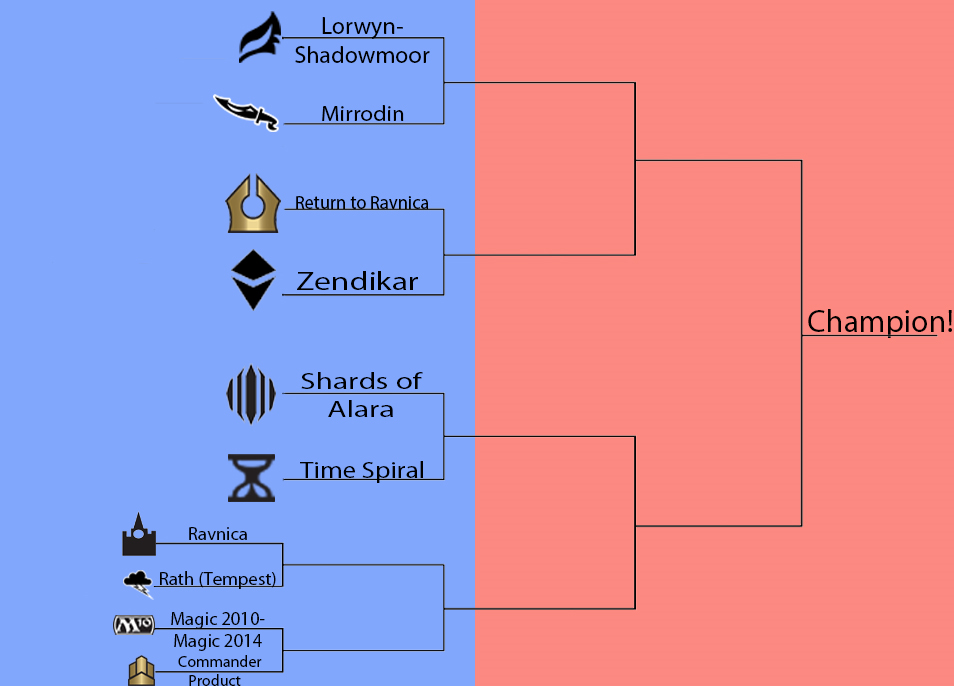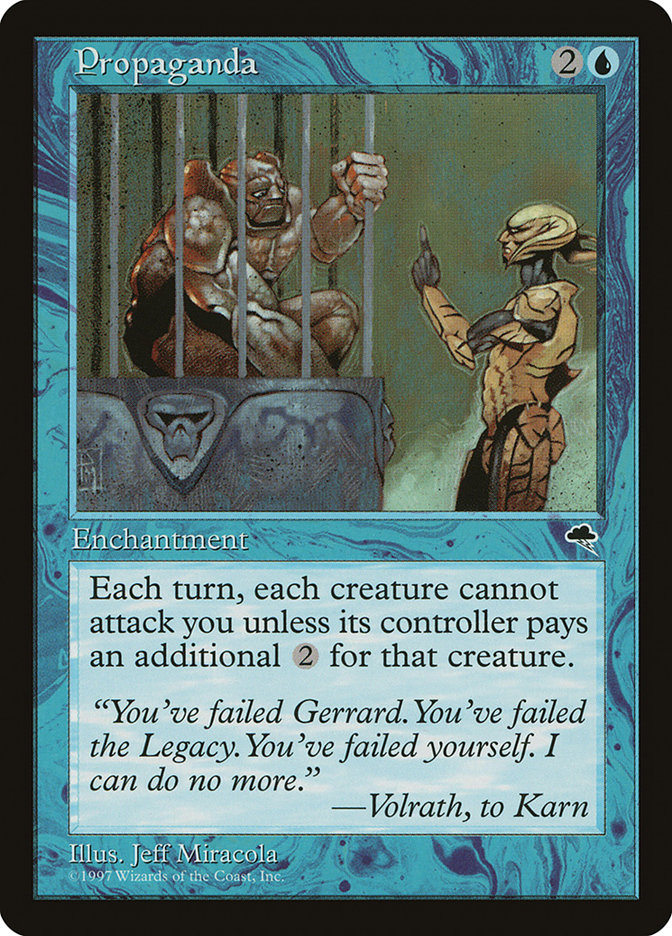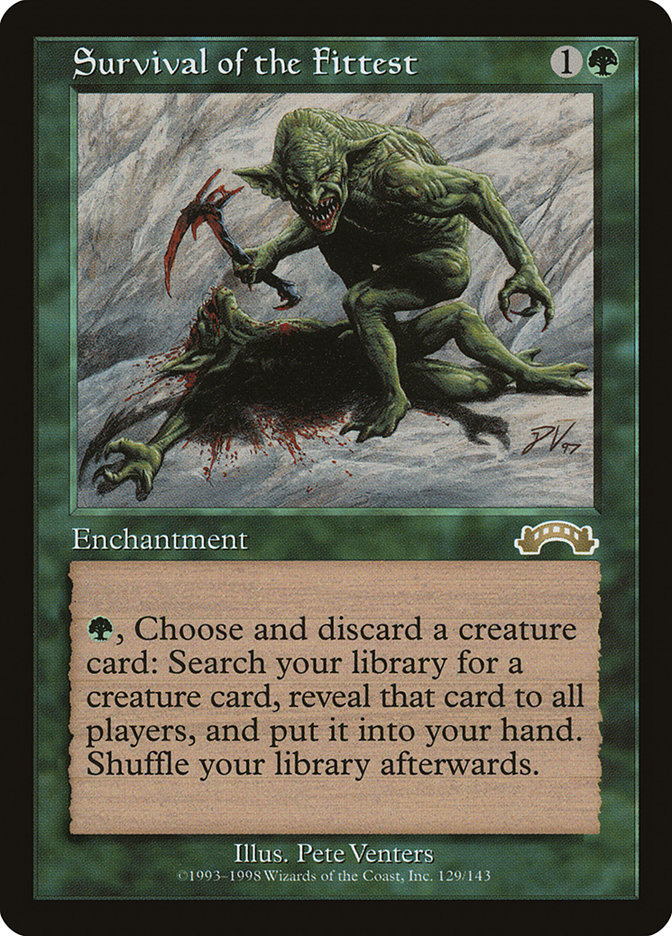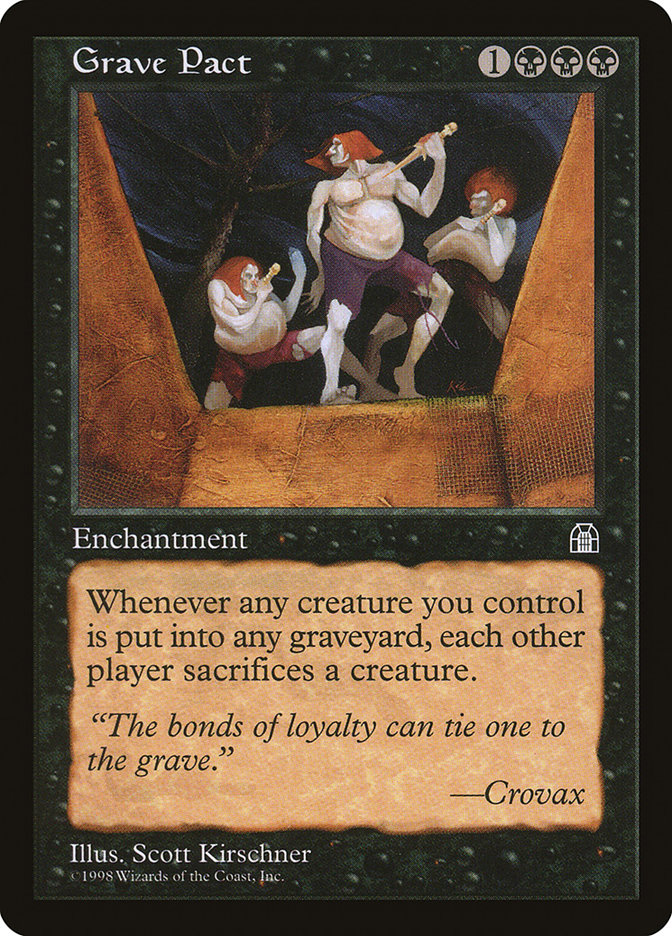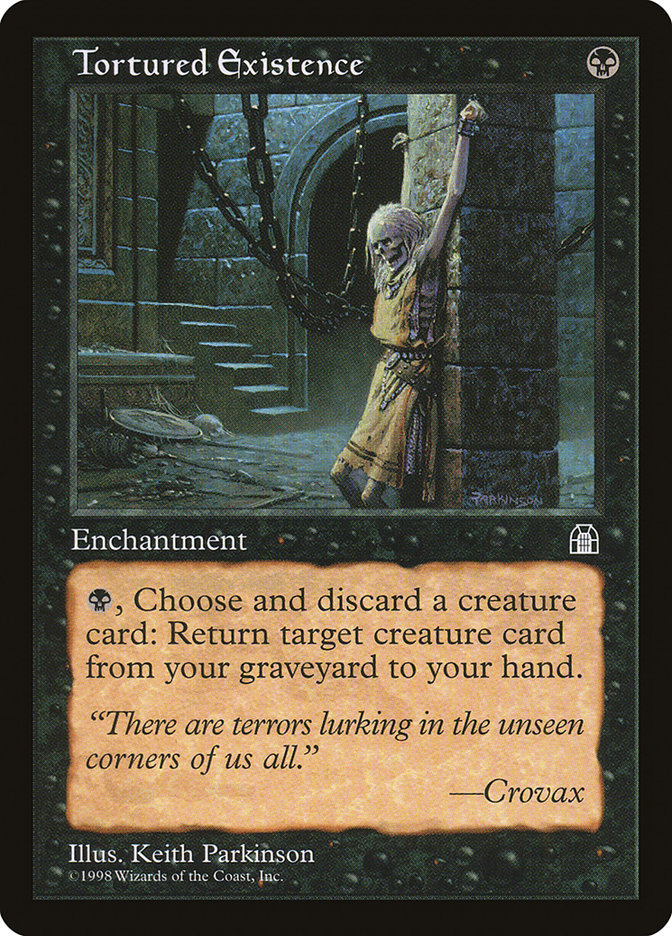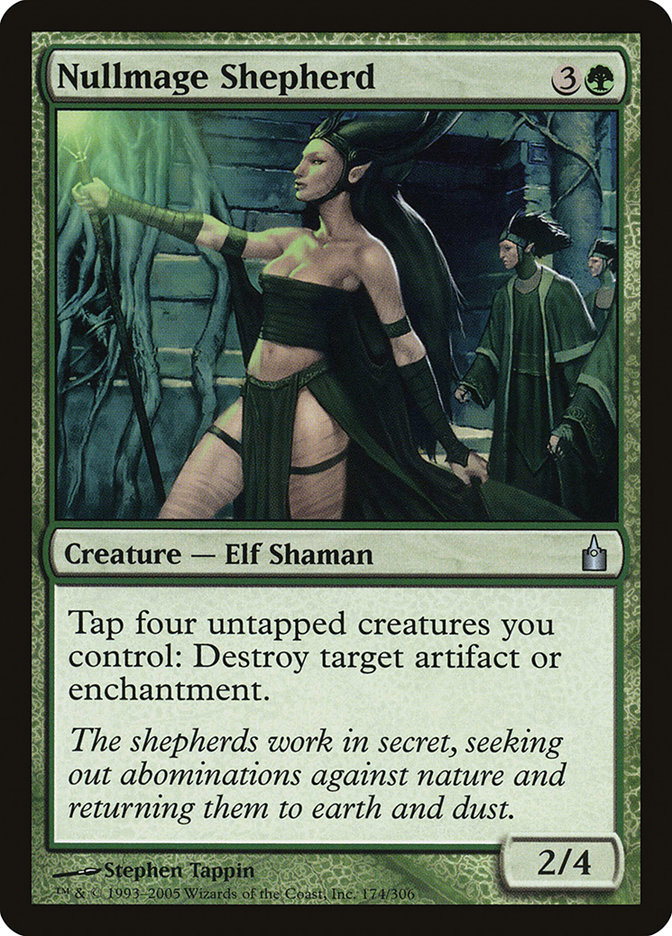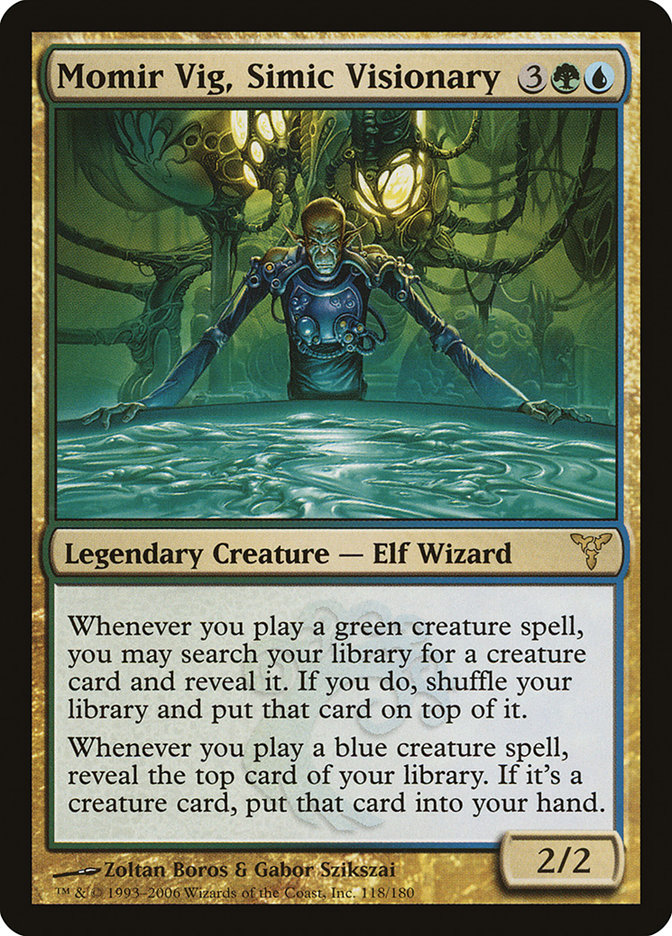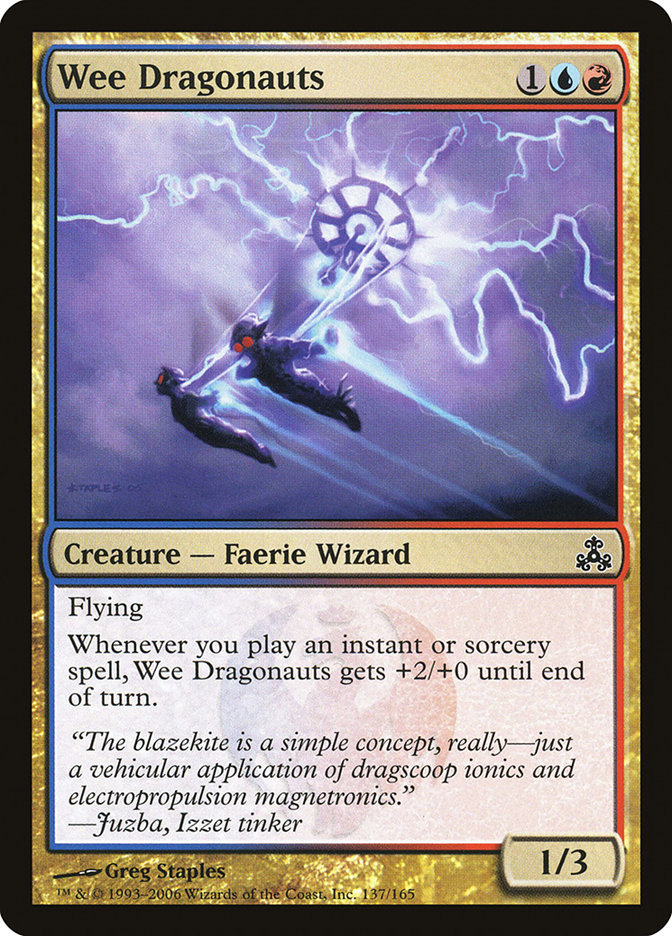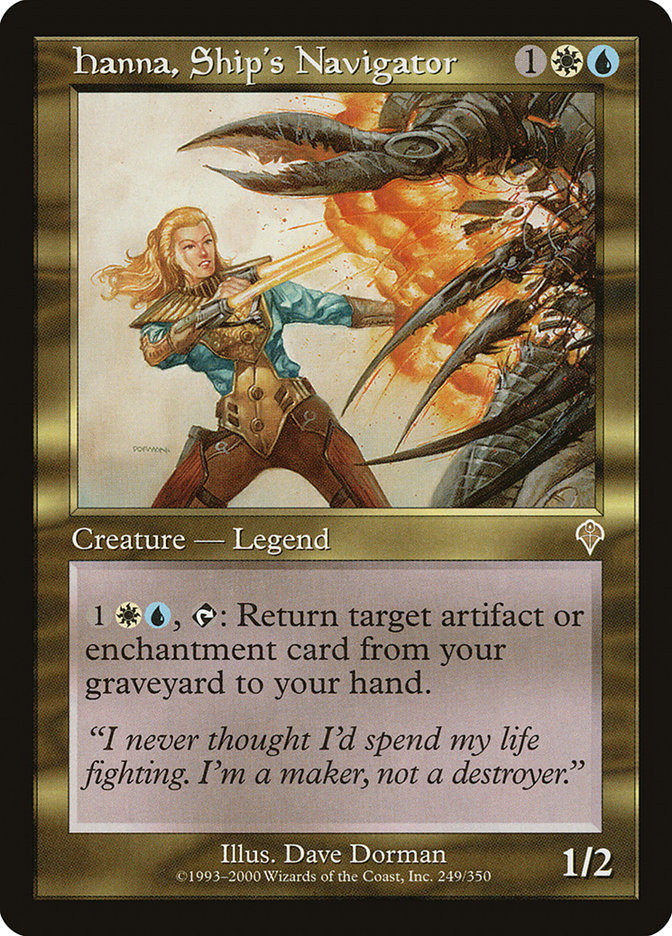This week’s Battle of the Blocks is a meeting between the classic Tempest block and one of the strongest contenders for the title in the original Ravnica block. Tempest block eliminated Onslaught block last round with a domination of the staples section on the back of amazingly powerful spells like the important Grave Pact and every green player’s favorite toolbox card Survival of the Fittest.
Flavor-wise Tempest block places you alongside the Weatherlight crew as they search throughout the plane of Rath and battle against the hive mind-guided slivers and the mysterious shadow creatures caught between worlds. The mechanics of Tempest block were progressive for their time, with the flavor-filled shadow mechanic bringing to life creatures trapped amid worlds and the buyback mechanic that rewarded solid cost assessment and the ability to properly sequence spells.
The beloved Ravnica block makes its entrance into the competition off of its first-round bye into the Battle of the Blocks as a heavy favorite to win the entire tournament. Ravnica block grabbed the multicolored theme and focused it into ten color pairs representing the ten guilds of Ravnica, each with its own flavor, mechanics, and legendary creatures that were an absolute hit with players. Ravnica block’s story revolves around the sacred guildpact that binds the energy of the city together and allows the guilds of Ravnica to live in peace. This block was such a hit with players that the setting was revisited this year in the Return to Ravnica block that has also been storming through the competition.
In order to set the scene for this battle, the current bracket is displayed below.
Remember, these battles are to decide which block contributed the most to Commander, not the best block in all of Magic. They will be compared in the usual five categories: Staples, Commanders, Strategies, Flavor, and The Bad.
Staples
Five Notable Staples From Tempest Block
1) Grave Pact
2) Survival of the Fittest
3) Living Death
4) Propaganda
5) Reflecting Pool
Tempest block shines in this section because of a trio of enchantments that act as catalysts for three of the most popular deck archetypes. The number one thing a control deck needs is time, and Propaganda provides the slower decks in the Commander format with the extra minutes they need in a multiplayer game by dissuading attacks through a simple mana payment method. Toolbox decks don’t need the extra time that a card like Propaganda brings to the board; they need a way to pull the perfect spell from their deck on demand, and Survival of the Fittest is one of the best ways to tutor up the exact answer to any problem. One of the greatest parts about Survival of the Fittest is its ability to put creatures into the graveyard for future reanimation or to bury utility cards like Genesis or Anger.
Grave Pact is the number one card on this list because of how pervasive it is in the format due to its inclusion in any deck that wants to sacrifice creatures or that rotates creatures in and out of the graveyard. The impact of this Tempest block enchantment is so large that multiple variations of the spell have been made, such as Martyr’s Bond and Butcher of Malakir.
Five Notable Staples From Ravnica Block
1) Shock Lands
2) Signets
3) Condemn
4) Karoo Lands
5) Angel of Despair
Mana fixing is instrumental to a great Commander deck so that cards like Insurrection can be played alongside other mana-intensive spells like Woodfall Primus, and Ravnica block brings low-cost and high-quality mana fixing to Commander. The shock lands and Karoo lands of Ravnica block are easily available tools for deckbuilders to use to create a great mana base for decks that play more than one color. The mana-fixing impact of Ravnica block is intensified with the printing of the cycle of Signets that are extremely common in decks that play a single color pair.
The strongest way to eliminate a problematic commander is to “tuck” the general by placing it on the bottom of the library. Condemn is a great answer to the Rafiq of the Manys and Kaalia of the Vasts of the world by investing a single white mana to make the problem go away for the rest of the game.
Cards To Consider
Tortured Existence is an engine that fuels a rather popular Pauper deck and a card that should see much more play in Commander. Not only is it low-cost recursion in any deck that looks to play creatures with great enters-the-battlefield abilities like Gray Merchant of Asphodel, but in decks that can take advantage of it through cards like Reveillark or Mulldrifter Tortured Existence becomes the best card on the board.
Nullmage Shepherd is a four-toughness enchantment and artifact-eating machine. In a token-based strategy or an Elf deck, this shaman keeps opponents honest by destroying important artifacts and enchantments like Gauntlet of Power, Mana Reflection, and Ghostly Prison.
Verdict: Tempest block brings enchantments and sorceries that define archetypes of the Commander format like Grave Pact and Survival of the Fittest, while Ravnica block makes sure that players can actually cast their spells. This category celebrates the cards that allow the format to function at a higher level, and the mana fixing from Ravnica combined with cards like Doubling Season and Angel of Despair barely edge out the all-stars of Tempest block.
Commanders
Just like with Return to Ravnica block, Ravnica block brings twenty legendary creatures to the Commander format with two generals for each color pair. The flavor of each guild radiates from these legends, bringing flavorful and functionally brilliant commanders to the format. Momir Vig, Simic Visionary marries blue card draw with green’s love of creatures to create a general that turns creatures that would be underpowered in the Commander format like Coiling Oracle into an Eladamri’s Call.
Niv-Mizzet, the Firemind uses intelligence instead of fire to quench the spark of life from his enemies. Players that use him for a general have found continued success running a controlling U/R deck that can finish off opponents with a large sorcery like Insurrection or by using Niv-Mizzet to combo out the table with a card like Mind Over Matter, Ophidian Eye, or Curiosity. Ravnica is the city of guilds, and each guild has two legendary creatures with which to explore the Commander format; although some of them may be subpar for the format, each of them is a healthy addition to Commander and is another reason why players love Ravnica block.
Tempest block fails to deliver when it comes to this category, bringing ten legends to the table that range from never played to sees occasional use. The most popular commander from Tempest block is the Sliver-spewing Sliver Queen that is usually the many-headed leader of a Sliver deck. Sliver Queen is no longer irreplaceable as the commander of the popular Sliver tribe, with two other five-color sliver Commanders in Sliver Legion and Sliver Overlord challenging the Queen for the top spot as the leader of the Slivers. In my experience, each commander leads to a different type of deck.
Sliver Overlord trumpets a more toolbox type of deck that looks to pull the perfect Sliver for any situation and playing cards like Amoeboid Changeling and Conspiracy. The Sliver Legion deck tends to focus on amassing a powerful contingent of Slivers by playing cards like Sliversmith and Riptide Replicator until they quickly finish off the game by casting Coat of Arms facsimile Sliver Legion. Tempest’s own Sliver Queen is the legendary creature of choice commonly for combo decks that utilize the Queen’s ability to churn out tokens with cards like Mana Echoes, Compost, and Heartstone to create an infinitely big swarm of the taloned creatures to eviscerate opponents.
Verdict: Tempest block doesn’t have the impactful legends like Ravnica block and handily loses this section to the twenty guild leaders and champions.
Strategies
Tempest is not a graveyard-focused set, but the amount of cards that assist graveyard-recursion and sacrifice-based strategies are numerous and powerful. Generals like the Shattergang Brothers; Savra, Queen of the Golgari; and Sek’Kuar, Deathkeeper turn to Tempest block for sacrifice outlets and catalysts like Goblin Bombardment, Grave Pact, and Altar of Dementia. Decks that look to the graveyard for recursion cherry pick spells like Reanimate and Living Death and use graveyard fillers Survival of the Fittest and Hermit Druid to stock the discard zone.
Tribal decks are an important part of the Commander scene, and Tempest not only brought the insanely popular Sliver tribe to Magic but it also unleashed the powerful artifact Coat of Arms onto kitchen tables everywhere. And let’s not forget decks like Borborygmos Enraged that throw lands with Seismic Assault or acquire extra lands or land drops with Tempest block spells Mulch, Burgeoning, and Horn of Greed.
Each guild in Ravnica block has their own mechanic, and some of these mechanics were so strong that they created entire decks built around them like the insanely powerful dredge mechanic. In Commander, Dredge isn’t nearly as explosive as its Legacy or Vintage counterparts, but cards like Stinkweed Imp and Golgari Grave-Troll still allow self-mill decks like The Mimeoplasm and Karador, Ghost Chieftain to work out of their own graveyards.
Doubling Season shifts token decks into overdrive while other Selesnya spells like Selesnya Guildmage and Selesnya Evangel create the tokens for Doubling Season to multiply. Life from the Loam and Sunforger are two cards that are strong enough to have their own decks built around them. Sunforger decks are commonly Boros decks playing Equipment fetchers like Stoneforge Mystic and Stonehewer Giant, while Life from the Loam decks are hybrid graveyard-recursion and cycling decks that end the game with huge spells like Living Death and Living End.
Verdict: The guilds of Ravnica block each brought a new mechanic and concept to Commander, creating sorely needed design space for deckbuilders. Tempest block eschewed the new mechanic strategy and instead provided powerful spells that strengthened established strategies and created new ones. The power within the cards from Tempest block outshines the mess of mechanics from Ravnica block and takes this section.
Flavor
The flavor from the city world of Ravnica block comes from the guilds that represent all of the two-color pairings in Magic. The Mark Rosewater-led design team did a great job of showcasing how these color pairs combine to achieve a similar goal by giving the couplings a specific mechanic and lore-related job.
The janitors of Ravnica, the green-black Golgari, have the most flavorful mechanic in dredge that couples creature and spell recursion with placing even more creatures into the graveyard. The Niv-Mizzet-led Izzet guild are a great example of the flavor found within this guild system as instant- and sorcery-loving colors blue and red are tied together in a steaming workshop of volatile lightning and flames. The interesting yet underwhelming replicate mechanic also comes out of the Izzet guild, but the great cards are found with creatures like Wee Dragonauts that feed off the eclectic energy.
The Weatherlight saga continued in Tempest block, where the crew fought against Greven il-Vec and the denizens of the plane of Rath. The idea behind the Weatherlight saga was to have an overarching story throughout multiple blocks to tie together each plane while still debuting new ideas and mechanics as the multiverse-hopping travelers voyaged from world to world.
Tempest block is where Creative got it right, creating a new world that had its own distinct themes and mechanics that wasn’t smothered with pictures of Gerrard Capashen and Hanna, Ship’s Navigator. The creatures tucked between planes in Rath are beautifully represented with the shadow mechanic while the overarching story is still progressed with cards like Diabolic Edict. The main reason why Tempest block is such a success in terms of flavor is its ability to solidify the world of Rath as a distinct plane, not just a storytelling stepping stone.
Verdict: The blocks are almost dead even in this category, but cards like Droning Bureaucrats and Steamcore Weird give Ravnica the win.
The Bad
Sometimes blocks bring harmful things into Commander. This time Tempest block introduced Limited Resources and Recurring Nightmare, while Ravnica block brought Legacy-winning beast Protean Hulk. Both Recurring Nightmare and Protean Hulk were banned because of how strong they were in the format. Protean Hulk was a one-card combo win and was constantly tutored up and sacrificed. Recurring Nightmare’s effect is simply too strong for the Commander format and was one of the first cards on the Commander banned list because of its unbridled power. The final card, Limited Resources, is a format-specific ban mainly because of how much it punishes people who don’t play artifact mana or get behind in a game.
Verdict: Recurring Nightmare was a plague on the format until it was banned, while Limited Resources is a spell that made its way onto the banned list to prevent unfun games. For this section, the one-card combo in Protean Hulk isn’t as bad as the game-destroying Limited Resources or powerful engine piece Recurring Nightmare. Ravnica block wins this section.
Final Verdict
For a quick look at the results from each section, I’ve decided to compile them into a report card for each block with a specific score for each section and a cumulative score for the block as a whole. I’ve stuck to a simple American grading system using letters instead of a numerical scale to keep the competition away from a simple tallying up of the results.
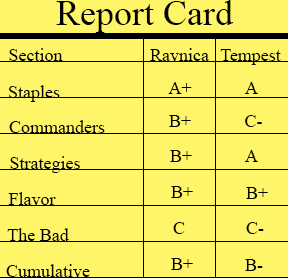
These blocks were very close in power level and contribution to the Commander format. The one big failing point of Tempest was its legendary creatures, which simply couldn’t match the guild leaders and champions of Ravnica block. Ravnica block wins this Battle Of The Blocks and advances to the Elite Eight to face the victor of the Commander product and the M10-M14 sets.

